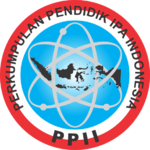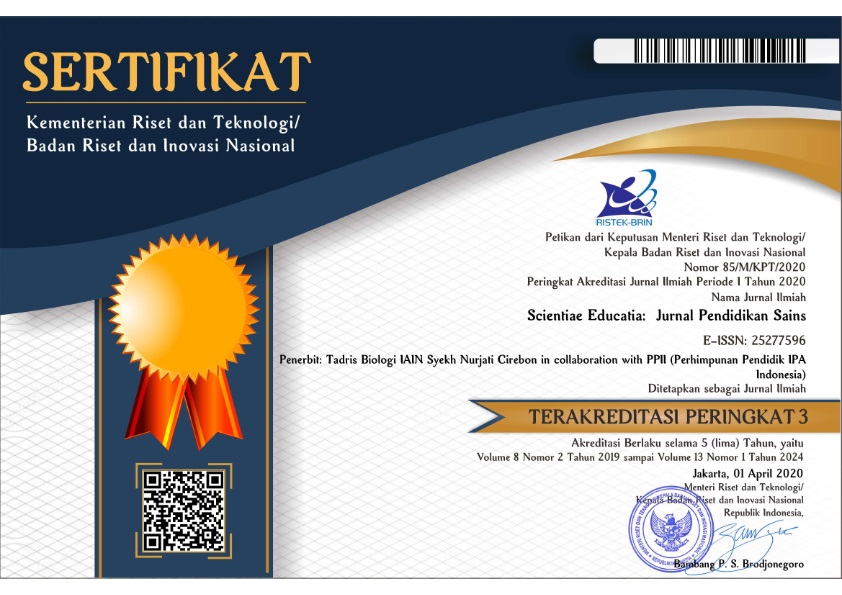Design Development Research Approach in Developing Gel Electrophoresis Virtual Laboratory to substitute Real Practicum
(1) Tadris Biologi, Fakultas Ilmu Tarbiyah dan Keguruan IAIN Syekh Nurjati Cirebon
(2) Tadris Matematika, Fakultas Ilmu Tarbiyah dan Keguruan IAIN Syekh Nurjati Cirebon
(3) Program Studi Pendidikan Biologi, Universitas Pendidikan Indonesia
(4) Program Studi Pendidikan Biologi, Universitas Pendidikan Indonesia
(*) Corresponding Author
Abstract
One of the purposes of Genetic practicum is that students can understand DNA separation techniques, by conducting gel electrophoresis practicum. Some Institutions of Teacher Training (LPTK) have problems in gel electrophoresis practicum due to unavailability of the lab. For this reason, it is necessary to try a replacement practicum in the form of a virtual laboratory to meet practicum objectives. This research uses a design development research (DDR) approach, through six stages, namely 1) identifying problems by determining indicators of learning and supporting literature studies, 2) determining the purpose, 3) designing and developing devices by designing virtual laboratories, determining the software that will be used, compiling a virtual laboratory storyboard and expert validation, 4) testing, 5) evaluating the results of the trial, and 6) communicating the results of the trial. The validated device was tested on a limited basis on 38 student participants who took genetic practicum. Data on laboratory reports on virtual laboratory gel electrophoresis were analyzed descriptively based on the students' ability to understand gel electrophoresis. 95.89% of students have the ability to understand gel electrophoresis.
Keywords
Full Text:
PDFReferences
Adi, W. C., Suratno, S., & Iqbal, M. (2016). Pengembangan Virtual Laboratory Sistem Ekskresi dalam Meningkatkan Motivasi Belajar Siswa SMA. Jurnal Pendidikan Sains, 4(4), 130-136. doi: 10.17977/jps.v4i4.8193
Adita, A., & Julianto, T. (2016). Penyusunan virtual laboratory sebagai media pembelajaran biologi. Jurnal Penelitian dan Pengabdian Kepada Masyarakat UNSIQ, 3(2), 69-73. doi: 10.32699/ppkm.v3i2.339
Alozie, N. M., Grueber, D. J., & Dereski, M. O. (2012). Promoting 21st-century skills in the science classroom by adapting cookbook lab activities: the case of DNA extraction of wheat germ. The american biology Teacher, 74(7), 485-489. doi: 10.1525/abt.2012.74.7.10
Argandi, R., Martini, K. S., & Saputro, A. N. C. (2013). Pembelajaran kimia dengan metode inquiry terbimbing dilengkapi kegiatan laboratorium real dan virtual pada pokok bahasan pemisahan campuran. Jurnal Pendidikan Kimia (JPK), 2(2), 44-49. Retrieved from https://eprints.uns.ac.id/11699/
Athaillah, A., Khaldun, I., & Mursal, M. (2017). Peningkatan pemahaman konsep siswa melalui laboratorium virtual pada materi listrik dinamis di SMA Negeri 1 Sukamakmur Aceh Besar. Jurnal Pendidikan Sains Indonesia, 5(1), 114-119.
Bakti, E. M. S., Suparmi, S., & Sunarno, W. (2013). Pembelajaran biologi melalui metode eksperimen dengan laboratorium riil dan laboratorium virtuil ditinjau dari kemampuan berfikir kritis dan gayabelajar siswa. Inkuiri, 2(03) doi: 10.20961/inkuiri.v2i03.9786
Bortnik, B., Stozhko, N., Pervukhina, I., Tchernysheva, A., & Belysheva, G. (2017). Effect of virtual analytical chemistry laboratory on enhancing student research skills and practices. Research in Learning Technology, 25. Retrieved from https://eric.ed.gov/?id=EJ1163194
Chen, Y. C., & Steenhoek, J. (2014). Arguing like a scientist: engaging students in core scientific practices. The American Biology Teacher, 76(4), 231-237. doi: 10.1525/abt.2014.76.4.3
Cunningham, S. C., McNear, B., Pearlman, R. S., & Kern, S. E. (2006). Beverage-agarose gel electrophoresis: an inquiry-based laboratory exercise with virtual adaptation. CBE—Life Sciences Education, 5(3), 281-286. doi: 10.1187/cbe.06-01-0139
Ejikeme, A. N., & Okpala, H. N. (2017). Promoting Children’s learning through technology literacy: challenges to school librarians in the 21st century. Education and Information Technologies, 22(3), 1163-1177.
Ellis, T. J., & Levy, Y. (2010, June). A guide for novice researchers: Design and development research methods. In Proceedings of Informing Science & IT Education Conference (InSITE) (Vol. 10, pp. 107-118).
Fitriyana, D. N., Ariani, S. R. D., & Mulyani, B. (2013). Pengaruh pembelajaran kimia dengan metode Student Team Achievement Division (STAD) yang dilengkapi eksperimen laboratorium riil dan virtualterhadap prestasi belajar pada materi pokok koloid ditinjau dari kemampuan memori siswa kelas XII a SMAN 8 Surakarta. Jurnal Pendidikan Kimia, 2(3), 130-138.
Gunawan, G., Harjono, A., & Sahidu, H. (2017). Studi pendahuluan pada upaya pengembangan laboratorium virtual bagi calon guru fisika. Jurnal Pendidikan Fisika dan Teknologi, 1(2), 140-145. doi: 10.29303/jpft.v1i2.250
Hamida, N., Mulyani, B., & Utami, B. (2013). Studi komparasi penggunaan laboratorium virtual dan laboratorium riil dalam pembelajaran Student Teams Achievement Division (STAD) terhadap prestasi belajar ditinjau dari kreativitas siswa. Jurnal Pendidikan Kimia, 2(2), 7-15.
Haynes, A., Lisic, E., Goltz, M., Stein, B., & Harris, K. (2016). Moving beyond assessment to improving students’ critical thinking skills: A model for implementing change. Journal of the Scholarship of Teaching and Learning, 16(4), 44-61.
Herga, N. R., ÄŒagran, B., & Dinevski, D. (2016). Virtual laboratory in the role of dynamic visualisation for better understanding of chemistry in primary school. Eurasia Journal of Mathematics, Science & Technology Education, 12(3), 593-608. doi: 10.12973/eurasia.2016.1224a
Herga, N. R., Grmek, M. I., & Dinevski, D. (2014). Virtual laboratory as an element of visualization when teaching chemical contents in science class. Turkish Online Journal of Educational Technology-TOJET, 13(4), 157-165.
Herrani, C. R. (2017). Penggunaan Virtual Lab untuk Meningkatkan Keterampilan mahasiswa pendidikan biologi dalam menggunakan alat-alat mikrobiologi. Widya Dharma: Jurnal Kependidikan, 27(2), 160-174.
Jacobson, M. J., Taylor, C. E., & Richards, D. (2016). Computational scientific inquiry with virtual worlds and agent-based models: new ways of doing science to learn science. Interactive Learning Environments, 24(8), 2080-2108.
Ketelhut, D. J., & Nelson, B. C. (2010). Designing for real-world scientific inquiry in virtual environments. Educational Research, 52(2), 151-167.
Kılıç, D., & Sağlam, N. (2014). Students’ understanding of genetics concepts: the effect of reasoning ability and learning approaches. Journal of Biological Education, 48(2), 63-70. doi: 10.1080/00219266.2013.837402
Kusdiastuti, M., Harjono, A., Sahidu, H., & Gunawan, G. (2017). Pengaruh Model Pembelajaran Inkuiri Berbantuan Laboratorium Virtual Terhadap Penguasaan Konsep Fisika Peserta Didik. Jurnal Pendidikan Fisika dan Teknologi, 2(3), 116-122.
Mthethwa-Kunene, E., Onwu, G. O., & de Villiers, R. (2015). Exploring biology teachers’ pedagogical content knowledge in the teaching of genetics in Swaziland science classrooms. International Journal of Science Education, 37(7), 1140-1165. doi: 10.1080/09500693.2015.1022624
Muhamad, M., Zaman, H. B., & Ahmad, A. (2010). Virtual laboratory for learning biology–a preliminary investigation. World Academy of Science, Engineering and Technology, 71, 572-575.
Nirwana, R. R. (2011). Pemanfaatan laboratorium virtual dan e-reference dalam proses pembelajaran dan penelitian ilmu kimia. Jurnal Phenomenon, 1(1), 116-117.
Pambudi, T., Mulyani, S., & Saputro, A. N. C. (2015). pengaruh pembelajaran kimia dengan model pembelajaran learning cycle 5E menggunakan laboratorium real dan virtual ditinjau dari sikap ilmiah terhadap prestasi belajar siswa pada materi pokok hidrolisis garam kelas XI MIPA SMA Negeri 3 Surakarta. Jurnal Pendidikan Kimia, 5(1), 78-87.
Prabowo, C. A., Ibrohim, I., & Saptasari, M. (2016). Pengembangan modul pembelajaran inkuiri berbasis laboratorium virtual. Jurnal Pendidikan: Teori, Penelitian, dan Pengembangan, 1(6), 1090-1097.
Rasyida, N., Tapilauw, F. S., & Pryandoko, D. (2015). Efektivitas pengembangan praktikum virtual untuk meningkatkan kemampuan berpikir kritis dan sikap ilmiah siswa sma pada konsep metagenesis tumbuhan lumut dan paku. In Prosiding Seminar Nasional Pendidikan Biologi (pp. 267-275).
Richey, R. C., & Klein, J. D. (2014). Design and development research: Methods, strategies, and issues. Routledge.
Sen, C., & Sezen Vekli, G. (2016). The impact of inquiry based instruction on science process skills and self-efficacy perceptions of pre-service science teachers at a University Level Biology Laboratory. Universal Journal of Educational Research, 4(3), 603-612.
Simbolon, D. H. (2015). Pengaruh model pembelajaran inkuiri terbimbing berbasis eksperimen riil dan laboratorium virtual terhadap hasil belajar fisika siswa. Jurnal Pendidikan dan Kebudayaan, 21(3), 299-316.
Son, J. Y. (2016). Comparing physical, virtual, and hybrid flipped labs for general education biology. Online Learning, 20(3), 228-243. doi: 10.25304/rlt.v25.1968
Swan, A. E., & O’Donnell, A. M. (2009). The contribution of a virtual biology laboratory to college students’ learning. Innovations in Education and Teaching International, 46(4), 405-419. doi: 10.1080/14703290903301735
Totiana, F., VH, E. S., & Redjeki, T. (2013). Efektivitas model pembelajaran creative problem solving (CPS) yang dilengkapi media pembelajaran laboratorium virtual terhadap prestasi belajar siswa pada materi pokok koloid kelas XI IPA semester genap SMA Negeri 1 Karanganyar tahun pelajaran 2011/2012. Jurnal Pendidikan Kimia, 1(1).
DOI: 10.24235/sc.educatia.v8i1.3961
Article Metrics
Abstract view : 320 timesPDF - 173 times
Refbacks
- There are currently no refbacks.
Scientiae Educatia: Jurnal Pendidikan Sains indexed by:

This work is licensed under a Creative Commons Attribution 4.0 International License.



1.png)












